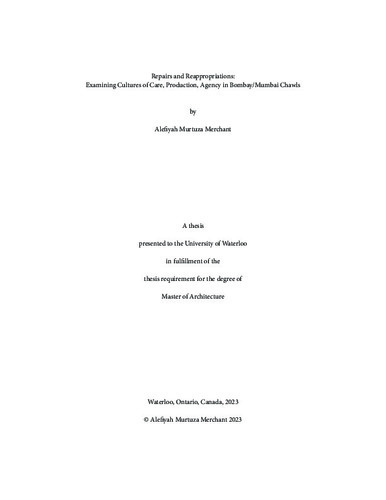| dc.description.abstract | This thesis is driven by unravelling the intricate dynamics of ‘marramat’/repair. As the focus broadened, the work began to consider reappropriation and reuse as spatial tactics of agency. The research is anchored within the unique context of Bombay/Mumbai Chawls and relies on narratives from the inhabitants to understand their everyday lives. These inhabitants, often from lower socio-economic backgrounds and traditionally pushed to the societal margins, play a pivotal role in shaping their spatial realities within the chawl typology. It links the universal to the subjective and argues that repair as a worldview holds significant value in how we view the every day, and that there is much to learn as architects when examining non-western ideas behind repair and mending.
Amidst the overarching challenges of breakdowns and the Capitalocene, this work aims to bring to the fore existing cultures of care and making and argues for reframing breakdowns and subsequent repairs as integral aspects of design processes. The study invites a nuanced understanding of how breakdowns, far from signifying the end, often mark the beginning of renewed cycles of use and significance.
The research employs a mixed-methods approach, blending primary fieldwork data (interviews, photographs) with secondary sources, supplemented by writings, drawings, and a stitching technique to draw attention to agency, care, and making. The research then narrows down by looking at micro-sites within the BDD chawl typology and its micro-narratives.
By tracing the socio-spatial transformation of the chawl typology from original design to its repaired states, this research posits an alternative to more disruptive approaches like demolition or redevelopment. Ultimately, it conceptualizes repair as more than a response, rather a deliberate act that challenges dominant design practices and paradigms, subverting the traditional role of the architect/planner. | en |

